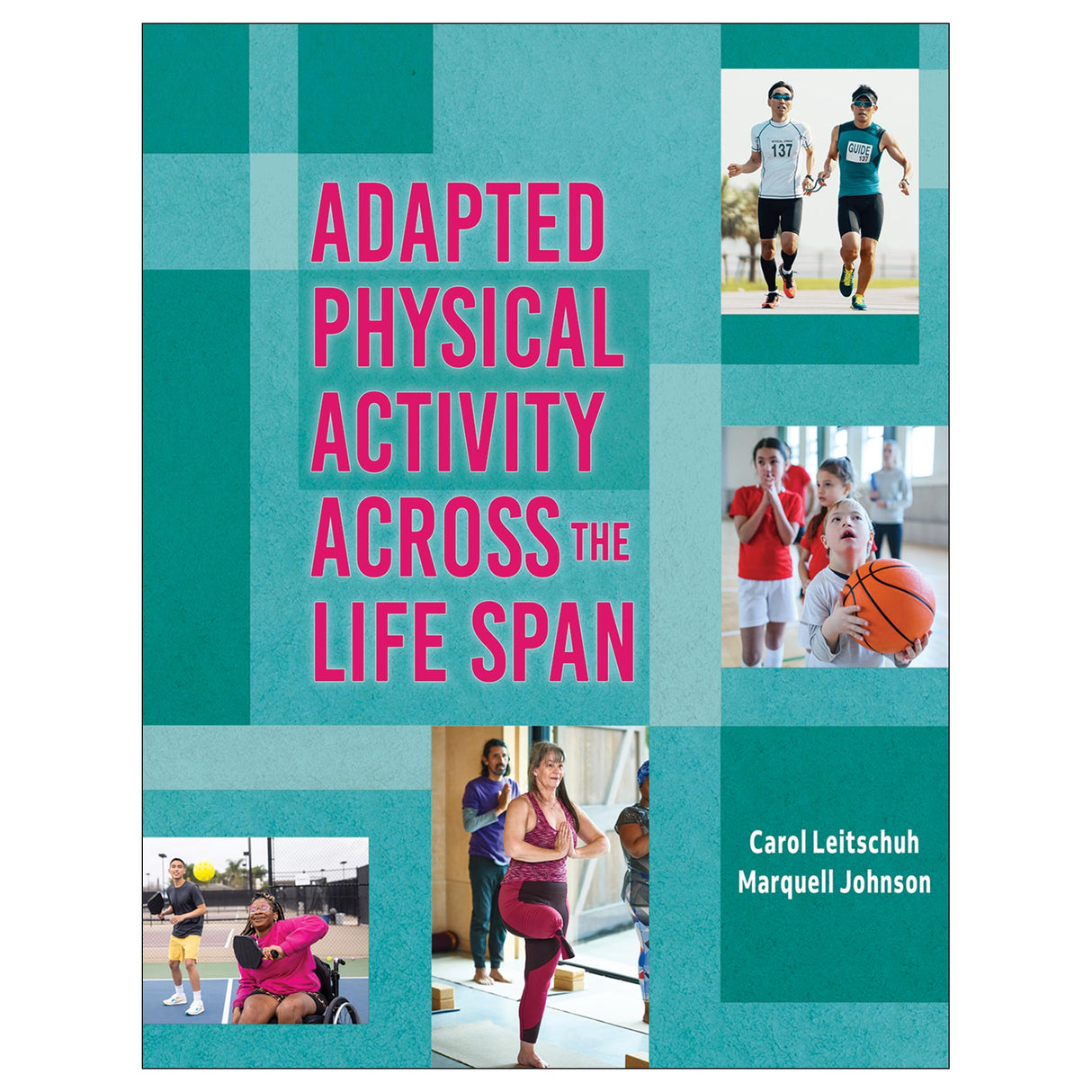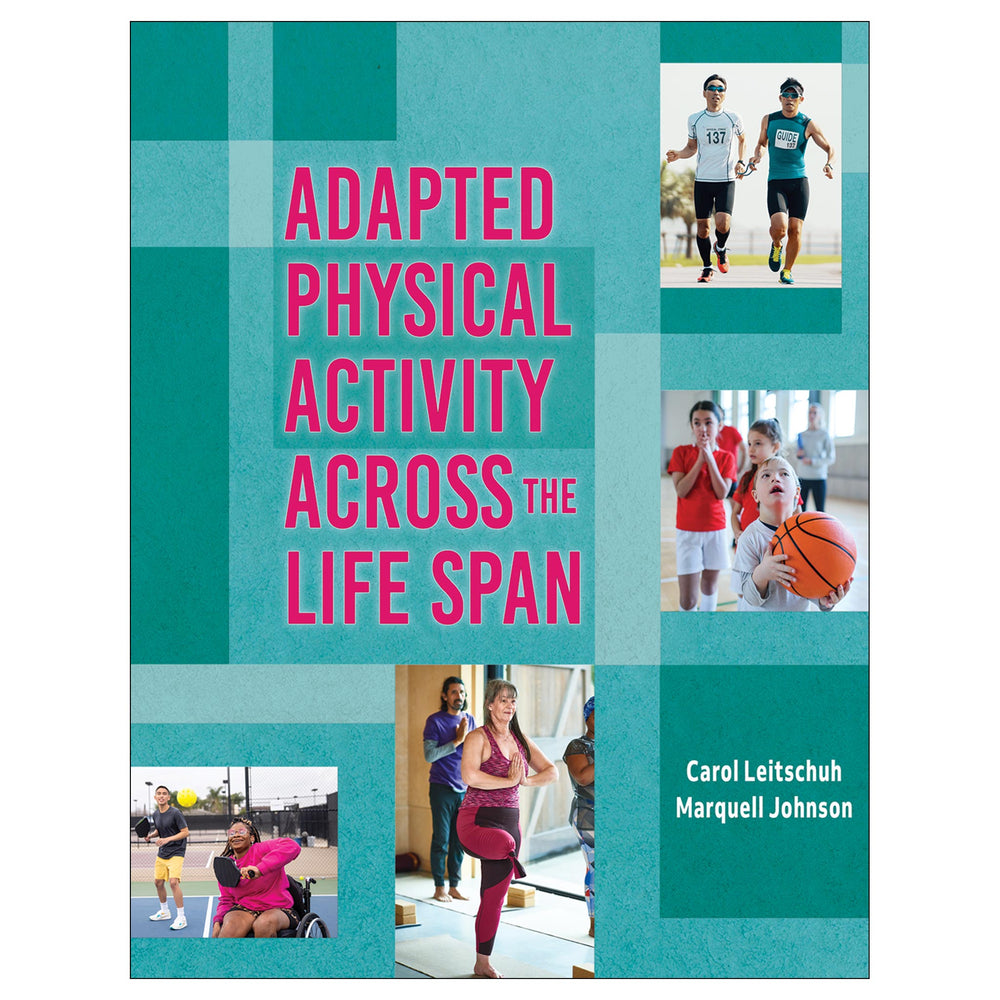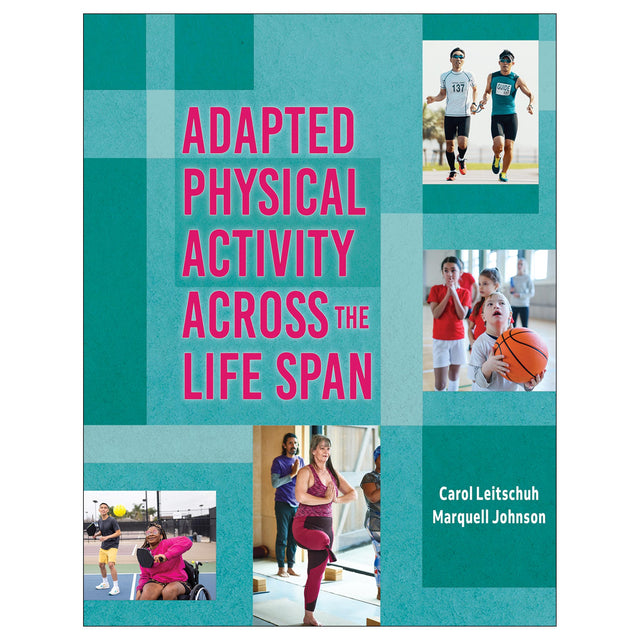Adapted Physical Activity Across the Life Span
Author: Carol Leitschuh, Marquell Johnson
$166.95 CAD
That’s because Adapted Physical Activity Across the Life Span takes a unique interdisciplinary approach from education, sports, and the health sciences. It incorporates adapted physical activity’s long history of DEI (diversity, equity, and inclusion) and the importance of SEL (social-emotional learning) to prepare pre-professionals and professionals for service delivery in today’s world.
Adapted Physical Activity Across the Life Span features the following:
- An interdisciplinary and life span approach to show students the broad scope of careers across education, clinical, and community settings
- Interviews with professionals that provide students with real-life stories from educators, allied health care professionals, coaches, and others who work with people with disabilities
- Information about adapted physical activity for early childhood, with a focus on professions that help a young child with a disability begin their journey of adapted physical education
- Content on adapted physical education for children and young people to educate students in the full implementation of IDEA and general physical education for children with disabilities, including interdisciplinary assessments, IEPs, and program modifications
- Content on adapted physical activity for adults to enable students to understand the roles of various professions that facilitate adapted physical activity for adults—from those who recently finished high school to senior citizens—using the Healthy People guidelines, research, best practices, and the most contemporary model of aging
- Chapter objectives, chapter summaries, tables, and charts that emphasize key concepts
- Instructor ancillaries to make it easier for instructors to prepare for and teach the course
“Today, the interdisciplinary nature of service in adapted physical activity begins in the earliest ages and continues with professionals who instruct and nurture the physical activity of the oldest of our communities,” says coauthor Carol Leitschuh. “This is the life span approach.”
Coauthor Marquell Johnson adds, “The interdisciplinary approach and life span approach provide a much wider view of helping people with disabilities achieve optimal health. Most texts focus on a narrower perspective, such as in school, in a medical or community setting, or with a certain age group. However, this book looks at all the professions that are involved in a person’s life throughout the life span and offers a coordinated approach.”
Adapted Physical Activity Across the Life Span will help prepare future professionals to serve individuals who require adaptations to be able to enjoy full and healthy active lives over their lifetimes. From infants to the elderly, all across the life span, people can be physically active—and this text will help them be just that.
Audience
An introductory methods textbook for undergraduates studying adapted physical education, physical education, rehabilitation science, occupational therapy, physical therapy, therapeutic recreation, speech and language pathology, early childhood education special education, and other disciplines in fitness, community recreation, sports, and allied health.Chapter 1. Physical Activity and Disability
History of Professional Disability Service
Understanding Disability
Life Course Perspective
Summary
Chapter 2. Professional Roles in Adapted Physical Activity
Professional Disciplines
Professionals in the Schools
Professionals in the Community
Professionals in Health Care
Summary
Chapter 3. Disability and the Law
Individuals with Disabilities Education Improvement Act of 2004
Americans with Disabilities Act Amendments Act of 2008
Every Student Succeeds Act of 2015
Individualized Education Program
Individualized Family Service Plan
Summary
Chapter 4. Designing Life Span Programs
Physical Activity Program Goals
Infants and Toddlers
Preschoolers
Kindergarteners
Elementary School Ages
Middle to High School Ages
Adults
Summary
Part II. Adapted Physical Activity in Schools
Chapter 5. Instructional Strategies
Ecological Theory
Developmental Systems Theory
Life Course Health Development
Universal Design for Learning
Motivation and Disability
Instructional Style
Instructional Techniques
Summary
Chapter 6. Assessment and Evaluation
Assessment Process
Evaluation Process
Legal Assessment Requirements
Approaches to Assessment
Screening Test Selection
Norm-Referenced Assessments
Nonstandardized Assessments
Evaluation Communication
Summary
Chapter 7. Intellectual Disability
Causes and Prevalence
Classification and Diagnosis
Instructional Considerations
Program Placement and Focus
Instructional Strategies
Physical Activities
Serving Students With Severe or Profound ID
Educational Health Care Providers
Summary
Chapter 8. Autism Spectrum Disorder
Causes and Prevalence
Classification and Diagnosis
Instructional Considerations
Program Placement and Focus
Instructional Strategies
Physical Activities
Assessment and Evaluation
Summary
Chapter 9. Specific Learning Disabilities and Attention-Deficit/Hyperactivity Disorder
Causes and Prevalence
Classification and Diagnosis
Instructional Considerations
Program Placement and Focus
Instructional Strategies
Physical Activities for Children With ADHD
Assessment and Evaluation for Children With SLD
Educational Health Care Providers
Summary
Chapter 10. Behavior Disorders
Causes and Prevalence
Classification and Diagnosis
Instructional Considerations
Program Placement
Instructional Strategies
Physical Activities
Assessment and Evaluation
Educational Health Care Providers
Summary
Chapter 11. Sensory Impairments
Causes and Prevalence
Classification and Diagnosis
Instructional Considerations
Program Placement and Focus
Instructional Strategies
Physical Activities
Assessment and Evaluation
Educational Health Care Providers
Summary
Chapter 12. Orthopedic Impairment and Traumatic Brain Injury
Causes and Prevalence
Classification and Diagnosis
Instructional Considerations
Program Placement and Focus
Instructional Strategies
Physical Activities
Assessment and Evaluation
Educational Health Care Providers
Summary
Chapter 13. Other Health Impairment
Obesity
Diabetes Mellitus
Asthma
Epilepsy
Human Immunodeficiency Virus
Sickle Cell Anemia
Hemophilia
Temporary Conditions of Disability
Summary
Part III. Adult Adapted Physical Activity
Chapter 14. Health-Related Fitness
Components of Health-Related Fitness
Exercise Intensity
Exercise Recommendations
Health and Disability
Exercise Initiation
Considerations for Selected Conditions
Summary
Chapter 15. Leisure Activity
Community and Professional Resources
Leisure Activity Checklist
Aging and Disability
Leisure Activity Recommendations
Summary
Chapter 16. Adapted Sport
Experience and Training
Adapted Sport in Adulthood
Professional Support
Classifications for Adapted Sport
Individual Sports
Dual Sports
Team Sports
Summary
Health and Disability
Intellectual Disability: Adaptive Functioning and Levels of Support
Orthopedic Impairment and Traumatic Brain Injury: Program Placement and Focus
Professional Roles in Adapted Physical Activity
All ancillaries are free to adopting instructors through HKPropel.
Instructor guide. Includes several resources that instructors can use throughout the semester as they organize and teach their course. In addition to a sample syllabus and course outline, instructors will find objectives, summaries, outlines, and tips for each chapter.
Test package. Contains over 350 questions in true-false, essay and short-answer, and multiple-choice formats. The files may be downloaded for integration with a learning management system or printed for use as paper-based tests. Instructors may also create their own customized quizzes or tests from the test bank questions.
Chapter quizzes. Contains ready-made quizzes (10 questions each) to assess student comprehension of the most important concepts in each chapter.
Presentation package. Features more than 300 PowerPoint slides of text, artwork, and photos from the book that can be used for class discussion and presentation. The slides in the presentation package can be used directly within PowerPoint or printed to make handouts for students. Instructors can easily add, modify, and rearrange the order of the slides.





